Mybatis操作
Mybatis基础操作
删除
接口方法
@Mapper
public interface EmpMapper {
//@Delete("delete from emp where id = 17")
//public void delete();
//以上delete操作的SQL语句中的id值写成固定的17,就表示只能删除id=17的用户数据
//SQL语句中的id值不能写成固定数值,需要变为动态的数值
//解决方案:在delete方法中添加一个参数(用户id),将方法中的参数,传给SQL语句
/**
* 根据id删除数据
* @param id 用户id
*/
@Delete("delete from emp where id = #{id}")//使用#{key}方式获取方法中的参数值
public void delete(Integer id);
}
@Delete注解:用于编写delete操作的SQL语句
如果mapper接口方法形参只有一个普通类型的参数,#{…} 里面的属性名可以随便写,如:#{id}、#{value}。但是建议保持名字一致。
日志输入
在Mybatis当中我们可以借助日志,查看到sql语句的执行、执行传递的参数以及执行结果。具体操作如下:
打开application.properties文件
开启mybatis的日志,并指定输出到控制台
#指定mybatis输出日志的位置, 输出控制台
mybatis.configuration.log-impl=org.apache.ibatis.logging.stdout.StdOutImpl
开启日志之后,我们再次运行单元测试,可以看到在控制台中,输出了以下的SQL语句信息:

但是我们发现输出的SQL语句:delete from emp where id = ?,我们输入的参数16并没有在后面拼接,id的值是使用?进行占位。那这种SQL语句我们称为预编译SQL。
预编译SQL
,性能更高,更安全(防止SQL注入)
在Mybatis中提供的参数占位符有两种:${…} 、#{…}
#{…}
- 执行SQL时,会将#{…}替换为?,生成预编译SQL,会自动设置参数值
- 使用时机:参数传递,都使用#{…}
${…}
- 拼接SQL。直接将参数拼接在SQL语句中,存在SQL注入问题
- 使用时机:如果对表名、列表进行动态设置时使用
注意事项:在项目开发中,建议使用#{…},生成预编译SQL,防止SQL注入安全。
新增
接口方法:
@Mapper
public interface EmpMapper {
@Insert("insert into emp(username, name, gender, image, job, entrydate, dept_id, create_time, update_time) values (#{username}, #{name}, #{gender}, #{image}, #{job}, #{entrydate}, #{deptId}, #{createTime}, #{updateTime})")
public void insert(Emp emp);
}
说明:#{…} 里面写的名称是对象的属性名
那要如何实现在插入数据之后返回所插入行的主键值呢?
- 默认情况下,执行插入操作时,是不会主键值返回的。如果我们想要拿到主键值,需要在Mapper接口中的方法上添加一个Options注解,并在注解中指定属性useGeneratedKeys=true和keyProperty=”实体类属性名”
主键返回代码实现:
@Mapper
public interface EmpMapper {
//会自动将生成的主键值,赋值给emp对象的id属性
@Options(useGeneratedKeys = true,keyProperty = "id")
@Insert("insert into emp(username, name, gender, image, job, entrydate, dept_id, create_time, update_time) values (#{username}, #{name}, #{gender}, #{image}, #{job}, #{entrydate}, #{deptId}, #{createTime}, #{updateTime})")
public void insert(Emp emp);
}
option注解标签useGeneratedKeys=true表示使用数据库自动增长的主键,keyColumn用于指定数据库table中的主键,keyProperty用于指定传入对象的成员变量。
@Options(useGeneratedKeys=true,keyProperty=”userId”,keyColumn=”userId”)
这个注解的意思就是,使用数据库自动增长的主键,并从table中userId字段里面把数据放到传入对象的成员变量userId里面。
如果我们已经在数据库表中指定了主键,那么keyColumn属性可以缺省。
更新
@Mapper
public interface EmpMapper {
/**
* 根据id修改员工信息
* @param emp
*/
@Update("update emp set username=#{username}, name=#{name}, gender=#{gender}, image=#{image}, job=#{job}, entrydate=#{entrydate}, dept_id=#{deptId}, update_time=#{updateTime} where id=#{id}")
public void update(Emp emp);
}
查询
根据ID查询
@Mapper
public interface EmpMapper {
@Select("select id, username, password, name, gender, image, job, entrydate, dept_id, create_time, update_time from emp where id=#{id}")
public Emp getById(Integer id);
}
数据封装
我们看到查询返回的结果中大部分字段是有值的,但是deptId,createTime,updateTime这几个字段是没有值的,而数据库中是有对应的字段值的,这是为什么呢?
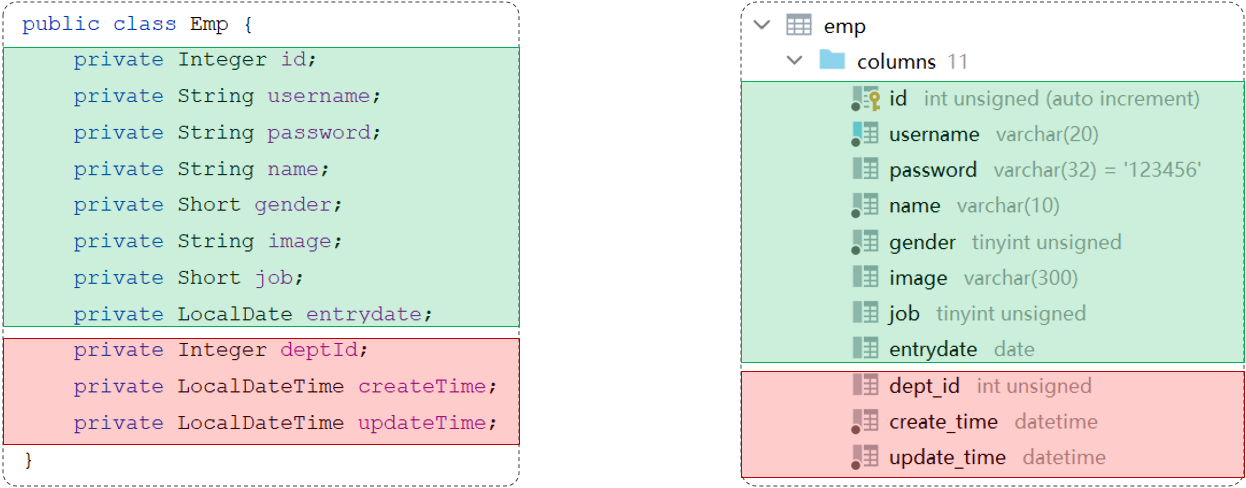
原因如下:
- 实体类属性名和数据库表查询返回的字段名一致,mybatis会自动封装。
- 如果实体类属性名和数据库表查询返回的字段名不一致,不能自动封装。
解决方案:
- 起别名
- 结果映射
- 开启驼峰命名
起别名:在SQL语句中,对不一样的列名起别名,别名和实体类属性名一样
@Select("select id, username, password, name, gender, image, job, entrydate, " +
"dept_id AS deptId, create_time AS createTime, update_time AS updateTime " +
"from emp " +
"where id=#{id}")
public Emp getById(Integer id);
再次执行测试类:
手动结果映射:通过 @Results及@Result 进行手动结果映射
@Results({@Result(column = "dept_id", property = "deptId"),
@Result(column = "create_time", property = "createTime"),
@Result(column = "update_time", property = "updateTime")})
@Select("select id, username, password, name, gender, image, job, entrydate, dept_id, create_time, update_time from emp where id=#{id}")
public Emp getById(Integer id);
@Results源代码:
@Documented @Retention(RetentionPolicy.RUNTIME) @Target({ElementType.METHOD}) public @interface Results { String id() default ""; Result[] value() default {}; //Result类型的数组 }@Result源代码:
@Documented @Retention(RetentionPolicy.RUNTIME) @Target({ElementType.METHOD}) @Repeatable(Results.class) public @interface Result { boolean id() default false;//表示当前列是否为主键(true:是主键) String column() default "";//指定表中字段名 String property() default "";//指定类中属性名 Class<?> javaType() default void.class; JdbcType jdbcType() default JdbcType.UNDEFINED; Class<? extends TypeHandler> typeHandler() default UnknownTypeHandler.class; One one() default @One; Many many() default @Many; }
**开启驼峰命名(推荐)**:如果字段名与属性名符合驼峰命名规则,mybatis会自动通过驼峰命名规则映射
驼峰命名规则: abc_xyz => abcXyz
- 表中字段名:abc_xyz
- 类中属性名:abcXyz
# 在application.properties中添加:
mybatis.configuration.map-underscore-to-camel-case=true
要使用驼峰命名前提是 实体类的属性 与 数据库表中的字段名严格遵守驼峰命名。
条件查询
@Mapper
public interface EmpMapper {
@Select("select * from emp " +
"where name like concat('%',#{name},'%') " +
"and gender = #{gender} " +
"and entrydate between #{begin} and #{end} " +
"order by update_time desc")
public List<Emp> list(String name, Short gender, LocalDate begin, LocalDate end);
}
参数名说明
参数名在不同的SpringBoot版本中,处理方案还不同:
- 在springBoot的2.x版本(保证参数名一致)

springBoot的父工程对compiler编译插件进行了默认的参数parameters配置,使得在编译时,会在生成的字节码文件中保留原方法形参的名称,所以#{…}里面可以直接通过形参名获取对应的值
- 在springBoot的1.x版本/单独使用mybatis(使用@Param注解来指定SQL语句中的参数名)

在编译时,生成的字节码文件当中,不会保留Mapper接口中方法的形参名称,而是使用var1、var2、…这样的形参名字,此时要获取参数值时,就要通过@Param注解来指定SQL语句中的参数名
Mybatis的xml配置文件
配置规范
在Mybatis中使用XML映射文件方式开发,需要符合一定的规范:
XML映射文件的名称与Mapper接口名称一致,并且将XML映射文件和Mapper接口放置在相同包下(同包同名)
XML映射文件的namespace属性为Mapper接口全限定名一致
XML映射文件中sql语句的id与Mapper接口中的方法名一致,并保持返回类型一致。

<select>标签:就是用于编写select查询语句的。
- resultType属性,指的是查询返回的单条记录所封装的类型。
配置文件实现
第1步:创建XML映射文件
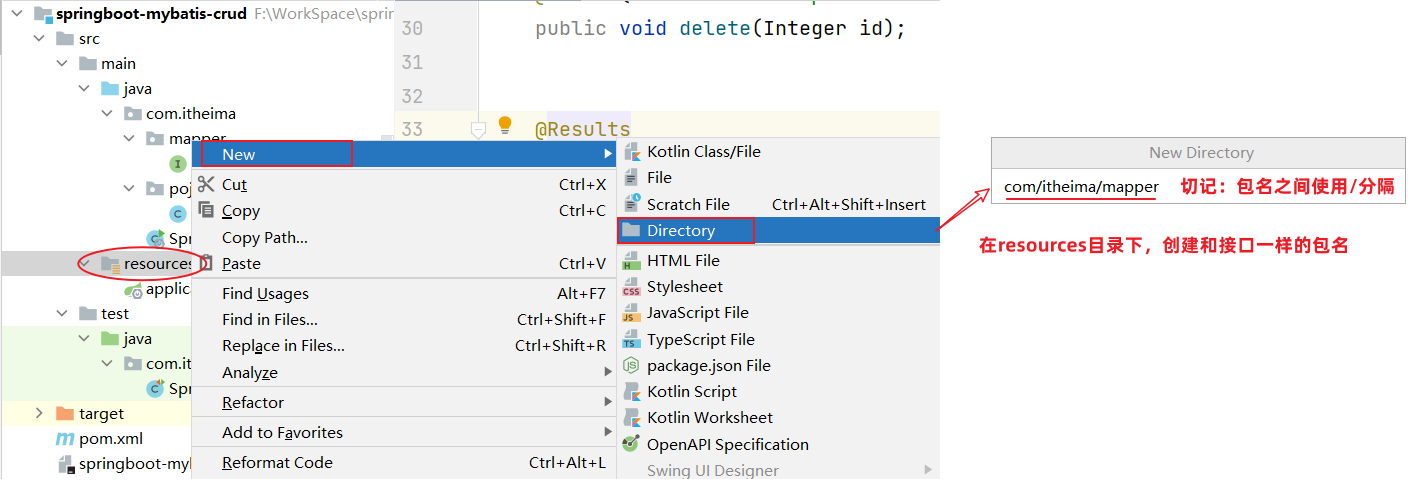

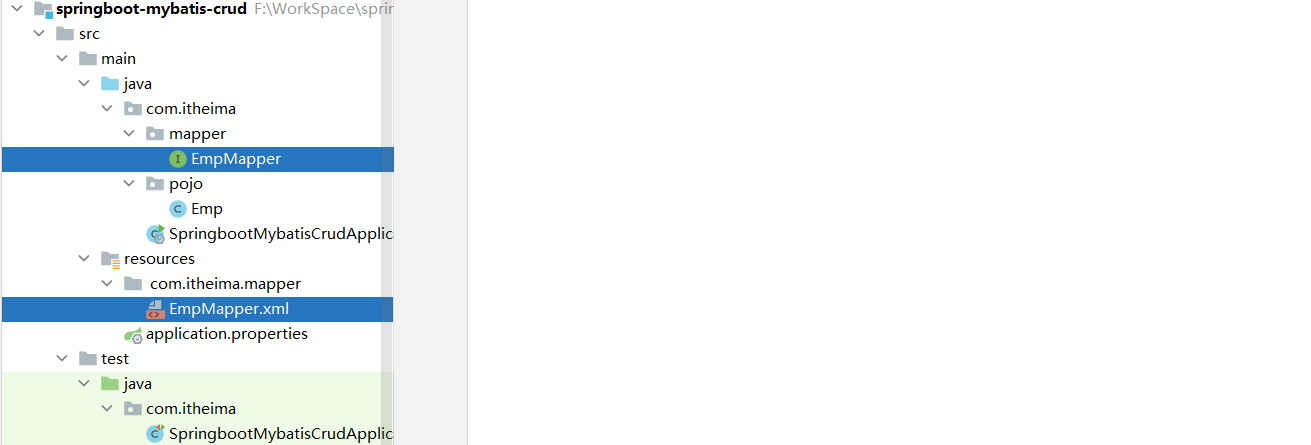
第2步:编写XML映射文件
xml映射文件中的dtd约束,直接从mybatis官网复制即可
<?xml version="1.0" encoding="UTF-8" ?>
<!DOCTYPE mapper
PUBLIC "-//mybatis.org//DTD Mapper 3.0//EN"
"https://mybatis.org/dtd/mybatis-3-mapper.dtd">
<mapper namespace="">
</mapper>
配置:XML映射文件的namespace属性为Mapper接口全限定名
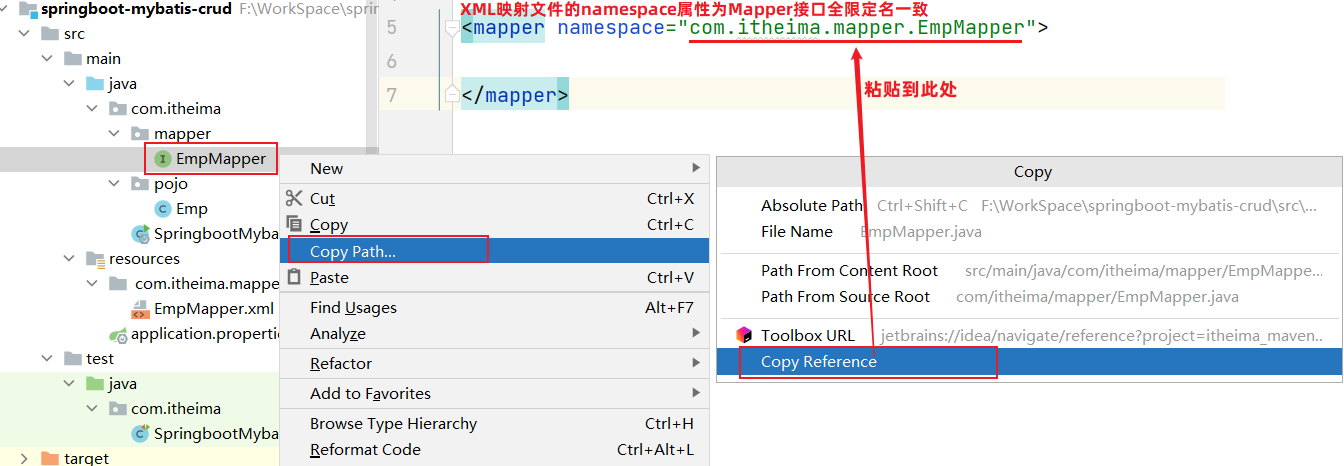
<?xml version="1.0" encoding="UTF-8" ?>
<!DOCTYPE mapper
PUBLIC "-//mybatis.org//DTD Mapper 3.0//EN"
"https://mybatis.org/dtd/mybatis-3-mapper.dtd">
<mapper namespace="com.itheima.mapper.EmpMapper">
</mapper>
配置:XML映射文件中sql语句的id与Mapper接口中的方法名一致,并保持返回类型一致
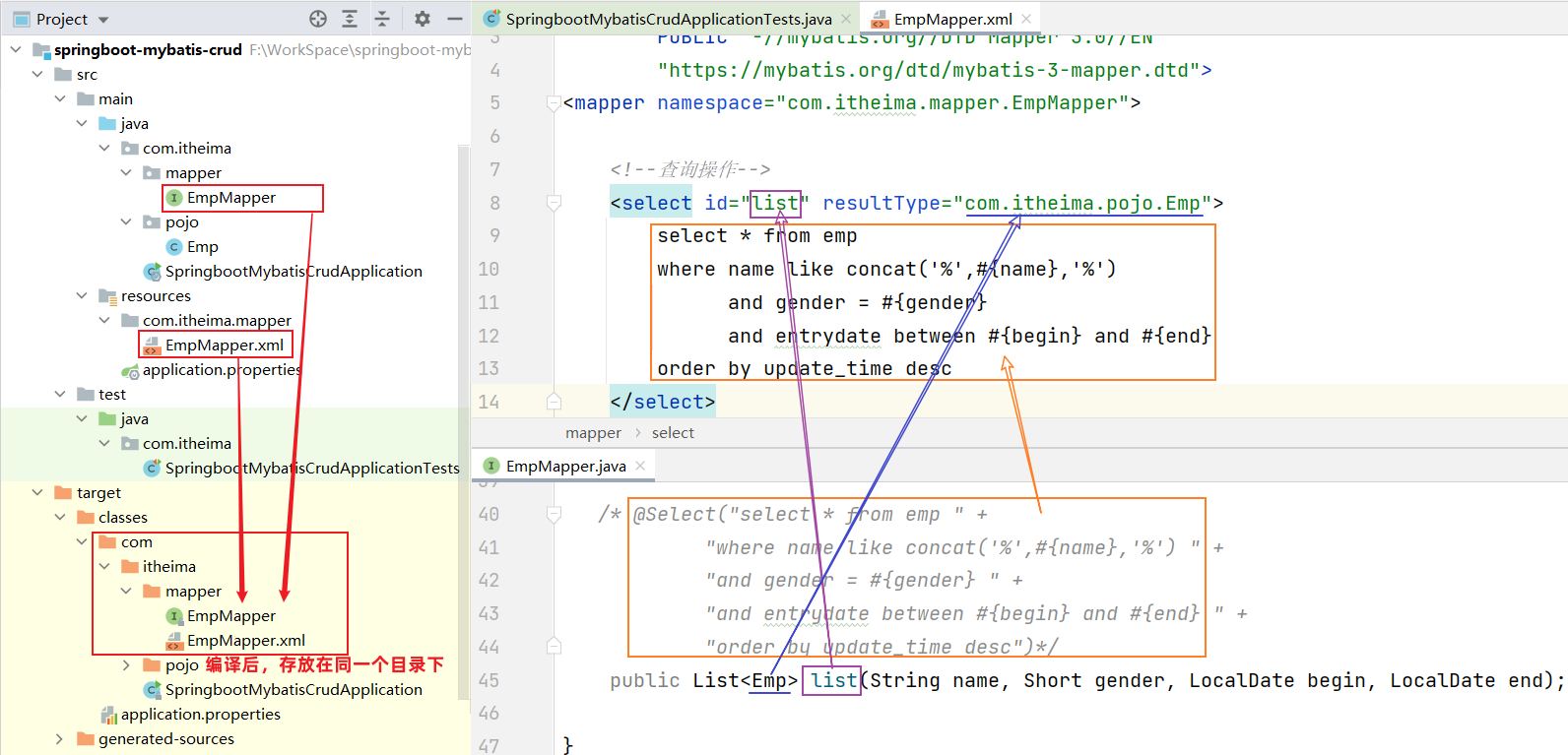
<?xml version="1.0" encoding="UTF-8" ?>
<!DOCTYPE mapper
PUBLIC "-//mybatis.org//DTD Mapper 3.0//EN"
"https://mybatis.org/dtd/mybatis-3-mapper.dtd">
<mapper namespace="com.itheima.mapper.EmpMapper">
<!--查询操作-->
<select id="list" resultType="com.itheima.pojo.Emp">
select * from emp
where name like concat('%',#{name},'%')
and gender = #{gender}
and entrydate between #{begin} and #{end}
order by update_time desc
</select>
</mapper>
动态SQL
动态SQL简介
SQL语句会随着用户的输入或外部条件的变化而变化,我们称为:动态SQL。

在Mybatis中提供了很多实现动态SQL的标签,我们学习Mybatis中的动态SQL就是掌握这些动态SQL标签。
SQL-if
<select id="list" resultType="com.itheima.pojo.Emp">
select * from emp
<where>
<!-- if做为where标签的子元素 -->
<if test="name != null">
and name like concat('%',#{name},'%')
</if>
<if test="gender != null">
and gender = #{gender}
</if>
<if test="begin != null and end != null">
and entrydate between #{begin} and #{end}
</if>
</where>
order by update_time desc
</select>
对于更新来说,也可以有
SQL-foreach
XML映射文件:
- 使用
<foreach>遍历deleteByIds方法中传递的参数ids集合
<foreach collection="集合名称" item="集合遍历出来的元素/项" separator="每一次遍历使用的分隔符"
open="遍历开始前拼接的片段" close="遍历结束后拼接的片段">
</foreach>
<mapper namespace="com.itheima.mapper.EmpMapper">
<!--删除操作-->
<delete id="deleteByIds">
delete from emp where id in
<foreach collection="ids" item="id" separator="," open="(" close=")">
#{id}
</foreach>
</delete>
</mapper>
SQL-sql&include
在xml映射文件中配置的SQL,有时可能会存在很多重复的片段,此时就会存在很多冗余的代码
我们可以对重复的代码片段进行抽取,将其通过<sql>标签封装到一个SQL片段,然后再通过<include>标签进行引用。
<sql>:定义可重用的SQL片段<include>:通过属性refid,指定包含的SQL片段
SQL片段: 抽取重复的代码
<sql id="commonSelect">
select id, username, password, name, gender, image, job, entrydate, dept_id, create_time, update_time from emp
</sql>
然后通过<include> 标签在原来抽取的地方进行引用。操作如下:
<select id="list" resultType="com.itheima.pojo.Emp">
<include refid="commonSelect"/>
<where>
<if test="name != null">
name like concat('%',#{name},'%')
</if>
<if test="gender != null">
and gender = #{gender}
</if>
<if test="begin != null and end != null">
and entrydate between #{begin} and #{end}
</if>
</where>
order by update_time desc
</select>






